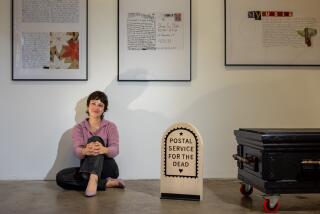Letters of Note’s Shaun Usher discusses the power of the written word
- Share via
In the twilight years of snail mail, fledgling British copywriter Shaun Usher launched Letters of Note, a blog dedicated to paper correspondence. Despite the obvious irony, the site quickly built a following. Readers connected with the personal written word — no matter whether it was fans writing to Elvis Presley, Nick Cave rejecting MTV’s nomination as best male artist or the Queen of England giving President Franklin Delano Roosevelt her recipe for scones.
All appear in the book “Letters of Note: An Eclectic Collection of Correspondence Deserving of a Wider Audience,” compiled by Usher. The book’s British debut included a live reading by Cave, Gillian Anderson and more; next week Benedict Cumberbatch will lead another Letters of Note event at the Hay Literary Festival in Wales.
The book is an oversized hardcover that includes images of the original letters, transcriptions, photos of some of the writers and notes from Usher. A letter from Annie Oakley is on striking letterhead; one believed to have been penned by Jack the Ripper is written in a slashing hand, on paper that is wrinkled and stained.
Usher, who lives in London, answered questions about the book by email.
When did Letters of Note begin?
The project began in September 2009, at which point I was a low-level copywriter — Don Draper, I most certainly was not — with very little interest in letters. Then, one fateful day that month, I decided to research the subject of famous correspondence, hopeful that it may spark some ideas for an article I needed to write for a client. I was instantly hooked and spent the next couple of days in the library poring over dusty old anthologies of old letters, blown away by the turn of phrase and epistolary skill displayed by people like Mark Twain and Marie de Sévigné. The blog was up and running the same week.
In the book, we get to see the letters themselves. When you were putting it together, were you handling actual archival materials?
Not so much for the book, but I have done over the years. The overriding emotion when coming into contact with the documents themselves is one of fear — fear that you will inadvertently damage an unspeakably precious piece of history. Once the hands stop shaking, you’re left in awe. I’ve also developed an expensive habit since beginning “Letters of Note”: purchasing letters of the rich and famous at auction. I’m now the proud owner of letters by Henry Miller, Stanley Kubrick, Katharine Hepburn, and others.... I just wish I were addicted to buying things that weren’t so flammable.
You include a terrifying letter from Jack the Ripper; your description of its contents, in contrast, is tremendously understated. How did you think about the relationship between the letters and what you wrote about them?
Early on, I decided to let the letters speak for themselves as much as possible and for this reason I try to keep my introductions concise and functional — I see them as suppliers of context, much the same as the labels found next to exhibits in a museum, and try not to overstate the letters’ content. Sometimes excitement takes hold and I fail in that regard, but on the large I think I’ve managed it.
Do you have/need permission to post the images and text of letters that you do on the blog?
I need permission for certain letters, of course — you will notice that many are old and therefore in the public domain, though; this saves me a lot of energy — and attempting to obtain such a thing is often an incredibly laborious task; however, that process sometimes puts me in touch with people linked to the letters — if not the writers themselves, then their families or friends — and furnishes me with information I otherwise wouldn’t have been privy to. In my search for permissions over the years, for example, I have had an email conversation with James Cameron about his opinion of “Poltergeist 2,” been in touch with the hugely welcoming family of a victim of the Lockerbie disaster, and spoken on the phone with an incredibly charming Harlan Ellison.
Where do you find the letters you share on the site?
Many places. Archives, museums, books, readers, blogs. Discovering the letters became markedly easier as the project grew in popularity, thanks to recommendations and submissions from people all over the globe — some connected to the letters, others simply their discoverers. These days letters are submitted by the very same archives and museums that I was once trawling for treasure....
Do you worry about running out of interesting letters?
Were I to continue compiling Letters of Note books for another 50 years, I would still just be scratching the surface when it comes to letters written before the end of the 20th century — so, in that respect, I don’t feel anxious in the slightest. My only worry, and it really is a bleak scenario, is that we are depressingly short of interesting letters written since the dawn of email, Facebook and Twitter, and that future generations won’t have the same luxury when it comes to sifting through our correspondence.
Simon Garfield, friend and author of the marvellous book “To The Letter,” put it best when he said — and I’m paraphrasing — “Years from now, rather than leaving boxes of charming old letters to our loved ones as was once the norm, we humans will be handing over passwords to our numerous email accounts.” And where is the romance in that?
More to Read
Sign up for our Book Club newsletter
Get the latest news, events and more from the Los Angeles Times Book Club, and help us get L.A. reading and talking.
You may occasionally receive promotional content from the Los Angeles Times.








